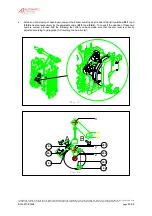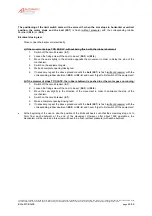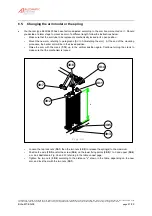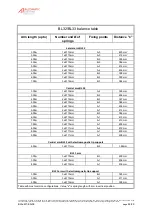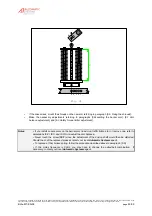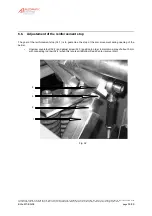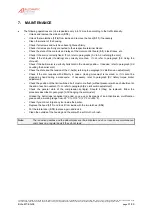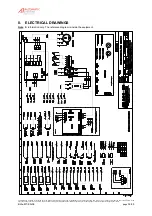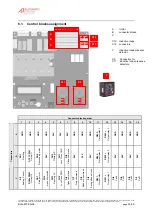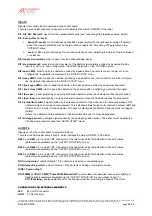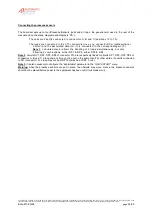
The information contained in this document is the property of Automatic Systems and is confidential. The recipient shall refrain from using it for any purpose other than the use of the products or the
execution of the project to which it refers, and from communicating it to third parties without Automatic Systems’ prior written agreement. Document subject to change without notice.
BL3x-MT-EN-08
page
40/59
5.10. Electrical connections and initial power-up
Warning
: high leakage current (between 3.5 mA and 5% of the nominal current).
Earth connection with a cable of minimum 1 mm² section mandatory before connecting power supply.
•
Make sure the power supply cables are not live
•
Connect the power supply to the main circuit breaker (
4:1
) according to the diagram inside the housing.
•
Connect the earth wire to its terminal (
4:2
).
•
Connect the control wires of whatever options to the connection block of the control board (6, p14),
according to the electric diagram.
•
Arm the overload protection of the electrical control board by switching on the circuit breaker (
4:1
). If the
installation includes one (or more) loop(s), make sure no vehicle activates it (them) since this might distort
the loop(s)' initialization.
•
Proceed with an electrical opening test (for example by pressing the OK key of the control board).
•
The motor may run without activating the arm. In this case, the sense of rotation of the motor must be
inversed To do it, switch off the power by switching off the circuit breaker(
4:1
), and reverse the connection of
the motor terminals U and V. Re-arm the overload protection by switching on the circuit breaker (
4:1
).
•
Fix the cables under the electrical control board by means of the cable binders provided.
•
Replace the control board by pushing it along its sliders.
5.11. Check-list
•
Before commissioning your barrier BL32/BL33, proceed with the general electrical tests (opening, closing,
emergency stop, electromagnetic tip support if installed, etc.). Then make sure to review the following
points:
--
Check if all screws and nuts have been tightened firmly.
--
Check if all wires are firmly connected to their respective terminal blocks.
--
Check if the arm is correctly fixed. If not, refer to
paragraphs [5.3 to 5.5 Installing the arm]
.
--
Check if the shrouds (if existing) are correctly mounted. If not, refer to
paragraph [5.6 Fixing the
shrouds]
.
--
Check if the barrier arm is perfectly horizontal in the closed position. If needed, refer to
paragraph [5.8
Levelling the barrier arm]
.
--
Check if the V-belt(s) is (are) properly adjusted referring to
paragraph [6.2. Belt tension adjustment]
.
--
Check if the arm reopens with difficulty in case a closing movement is reversed, or if it cannot be
stopped by hand during a manoeuvre. If necessary, refer to
paragraph [6.3 Safety torque limiter
adjustment]
.
--
Since the mechanism has not been run in, the position of the limit switches is such that the bolt stops at
2-3mm from each abutment at the end of the movement. After about 1000 operations, the mechanism
will be run in and this bolt will have to be flush with each abutment. Please refer to paragraph
[6.4 Limit
switch adjustment]
.
--
Check if you did not forget any tool inside the barrier.
--
Remove any foreign body from the inside of the barrier (scraps, etc.) and clean.
--
Replace the hood (
3:11
) and lock it from inside with the two latches (
3:16
).
--
Put the lateral door (
3:10
) in place again and lock it.
--
The barrier is now operational. Although all adjustments have been carried out in factory, a final
regulation may be required after the transport or mounting procedure. In this case, see
chapter [6]
.
5.12. Scrapping the equipment
•
When the equipment is withdrawn from use, Do not fail, , to empty the oil from the gearbox (
3:2
) and to scrap
the various elements of the machine in the appropriate way (metal parts, electronic components, etc.) in line
with your country code/regulations.




















